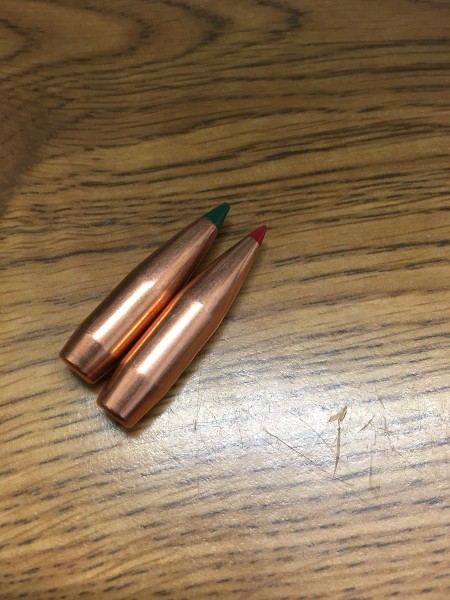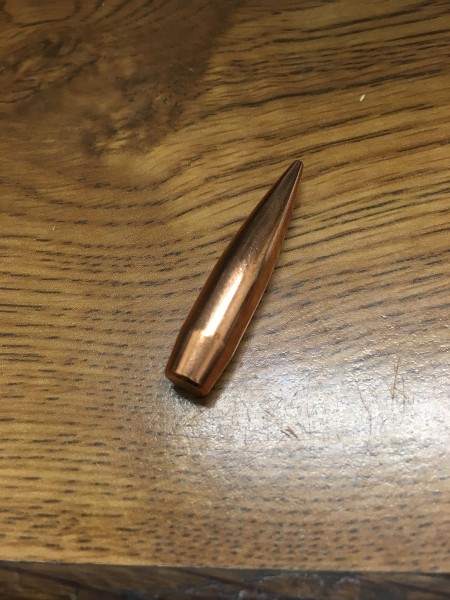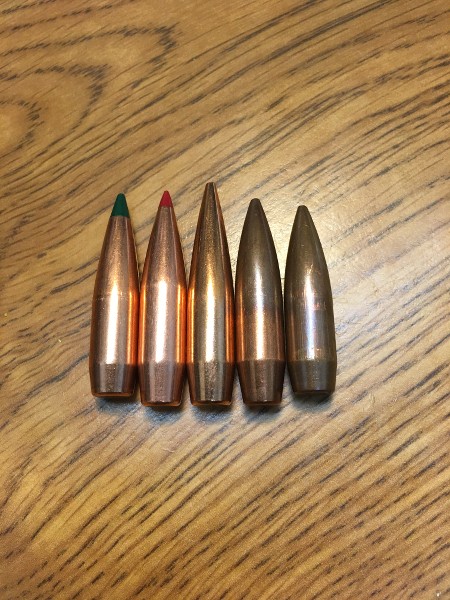
 |
|
|
#1 |
|
Senior Member
Join Date: April 10, 2012
Location: San Diego CA
Posts: 6,876
|
Ogive , what is it ?
I always thought I had a good understanding of what the ogive of a bullet is . I still do but realized I don’t have it in my vocabulary to explian what it is or at least don’t know how to explain it in detail.
What’s the best , quickest and most detailed way to explain what the ogive of a bullet is to someone who has never heard of the term ? Is it the area of the bullet where the profile of the bullet changes from the full diameter of the caliber to the tapered angle of the nose ? What’s the best way to say it ? Or should that be said backwards. It’s where the tapered angle of the nose transitions to the full diameter of the projectile ?
__________________
If Jesus had a gun , he'd probably still be alive ! I almost always write my posts regardless of content in a jovial manor and intent . If that's not how you took it , please try again .  
Last edited by Metal god; November 7, 2018 at 10:46 AM. |
|
|
|
|
#2 | |
|
Staff
Join Date: March 4, 2005
Location: Ohio
Posts: 21,063
|
From the SAAMI glossary:
Quote:
__________________
Gunsite Orange Hat Family Member CMP Certified GSM Master Instructor NRA Certified Rifle Instructor NRA Benefactor Member and Golden Eagle |
|
|
|
|
|
#3 |
|
Senior Member
Join Date: April 10, 2012
Location: San Diego CA
Posts: 6,876
|
That definition would seem to indicate the ogive is not a fixed point but rather can be measured from many different points on the projectile . Example some Berger VLD have a short curved area then a long pretty flat area to the tip . While round nose bullets are pretty much curved the entire area forward of the baring surface all the way to the tip . On a round nose bullet , is the entire nose area minus the tip considered the ogive ?
__________________
If Jesus had a gun , he'd probably still be alive ! I almost always write my posts regardless of content in a jovial manor and intent . If that's not how you took it , please try again .  
|
|
|
|
|
#4 |
|
Senior Member
Join Date: March 2, 2017
Posts: 1,868
|
Way I get it is it's the first part of the bullet to touch the lands in the barrel.
|
|
|
|
|
#5 |
|
Senior Member
Join Date: August 22, 2009
Posts: 180
|
In the machining, inspection, quality control, & engineering sector the point where the radius begins and the full dia ends would be referred to as the tangent point. Tangent point is also the intersection point of 2 lines forming an angle.
It's been a while, better double check. |
|
|
|
|
#6 | ||
|
Moderator Emeritus
Join Date: June 25, 2008
Location: Austin, CO
Posts: 19,578
|
Quote:
Quote:
__________________
Nobody plans to screw up their lives... ...they just don't plan not to. -Andy Stanley |
||
|
|
|
|
#7 | |
|
Senior Member
Join Date: November 30, 2012
Location: Baton Rouge, Louisiana
Posts: 1,752
|
Quote:
Ogives vary in arch dimension and length . Gary |
|
|
|
|
|
#8 |
|
Senior Member
Join Date: July 18, 2008
Posts: 7,249
|
And you can turn it over to the young students, my wife has taught school for 30+ years, she would expect one of the young ones to come up with something like:
"Ogive me a home where the buffalo roam" and then there was the parent that came to see her about the pronouncing of her Childs name. The parent claimed the 'dash' was not silent. F. Guffey |
|
|
|
|
#9 | |
|
Staff
Join Date: March 4, 2005
Location: Ohio
Posts: 21,063
|
Quote:
__________________
Gunsite Orange Hat Family Member CMP Certified GSM Master Instructor NRA Certified Rifle Instructor NRA Benefactor Member and Golden Eagle |
|
|
|
|
|
#10 |
|
Senior Member
Join Date: April 10, 2012
Location: San Diego CA
Posts: 6,876
|
Ok I'm will to except the ogive is any part of the nose of the bullet after the tip and before the diameter of the barring surface . I always thought of it as the portion closest to the diameter of the baring surface . It's funny though because my micrometer seating stems by this definition all seat off the ogive but are engaging the ogive WAY out by the tip of the bullets nowhere near the baring surface .
__________________
If Jesus had a gun , he'd probably still be alive ! I almost always write my posts regardless of content in a jovial manor and intent . If that's not how you took it , please try again .  
|
|
|
|
|
#11 |
|
Staff
Join Date: March 4, 2005
Location: Ohio
Posts: 21,063
|
Yes. And ogive isn't just for bullets. It's an engineering geometry term and can apply to 2 dimensional shapes, too. The Wikipedia has it here. As an example, the gothic arches in church architecture that have a sharp point rather than the rounded tip of the Roman arch is called an ogive.
__________________
Gunsite Orange Hat Family Member CMP Certified GSM Master Instructor NRA Certified Rifle Instructor NRA Benefactor Member and Golden Eagle |
|
|
|
|
#12 |
|
Senior Member
Join Date: February 13, 2002
Location: Canada
Posts: 12,453
|
It's the part of the bullet/cartridge that has nothing whatever to do with the OAL.
Merriam and her dictionary says, "1a : a diagonal arch or rib across a Gothic vault b : a pointed arch(that's a Spitzer bullet) 2 : a graph of a cumulative distribution function or a cumulative frequency distribution." And it's 'bearing surface" not 'baring'.
__________________
Spelling and grammar count! |
|
|
|
|
#13 | |
|
Staff
Join Date: March 4, 2005
Location: Ohio
Posts: 21,063
|
Quote:
__________________
Gunsite Orange Hat Family Member CMP Certified GSM Master Instructor NRA Certified Rifle Instructor NRA Benefactor Member and Golden Eagle |
|
|
|
|
|
#14 |
|
Senior Member
Join Date: August 22, 2009
Posts: 180
|
The ogive can have a tangent radius; that is, the intersection of the body of the bullet and the radius of the ogive blend together at a tangent point. This is the most common type and is typical of most bullets handloaders use. The other common type is the secant ogive.
Bullet Design–Secant vs. Tangent Ogive « Daily Bulletin bulletin.accurateshooter.com/2007/07/283/ |
|
|
|
|
#15 | |
|
Staff
Join Date: March 11, 2006
Location: Upper US
Posts: 28,833
|
Quote:
No, the ogive never touches the barrel. The ogive is the curved/sloped/slanted/tapered part of the bullet between the leading edge of the bearing surface (the full diameter part that DOES touch the lands) and the tip (or meplat) of the bullet. The Ogive is that entire area, and anyone using the term "measured to the ogive" is referring to measuring to a point on the ogive that THEY picked. Which can, of course be a different spot for each person doing the picking...
__________________
All else being equal (and it almost never is) bigger bullets tend to work better. |
|
|
|
|
|
#16 |
|
Senior Member
Join Date: March 1, 2009
Posts: 4,232
|
In reality it originated as a architectural shape used to describe cathedral windows.
When I am talking reloading though I, like most everyone I know, consider it the farthest forward part of the bearing surface of the bullet where the real ogive begins. In other words the first part of the bullet to contact the throat.
__________________
“How do I get to the next level?” Well, you get to the next level by being the first one on the range and the last one to leave.” – Jerry Miculek |
|
|
|
|
#17 |
|
Staff
Join Date: March 4, 2005
Location: Ohio
Posts: 21,063
|
As shown in my drawing, the intersection of bearing surface and ogive is called the shoulder. The part of the bullet that maintains contact with the floor of the grooves is the bearing surface. The part that first makes contact with the lands is the beginning (going from base to nose) of the ogive where is just starts to come away from the shoulder, but behind it the bearing surface becomes impressed into the distorted cross-section.
__________________
Gunsite Orange Hat Family Member CMP Certified GSM Master Instructor NRA Certified Rifle Instructor NRA Benefactor Member and Golden Eagle |
|
|
|
|
#18 |
|
Senior Member
Join Date: July 18, 2008
Posts: 7,249
|
And then there the two diameters of the bore; the .308 diameters are .300" and .308". When the rifling contacts the bullet it has to be between .300" and .308". I have never has an infatuation with 'ogive'.
F. Guffey |
|
|
|
|
#19 | |
|
Senior Member
Join Date: August 18, 2016
Posts: 206
|
Quote:
My wife also had to be corrected that a students name “la-a” was pronounced “ladasha” not “la ah”. Andrew - Lancaster, CA NRA Life Member, Calguns.net contributor, CGF / SAF / CRPA / FPC / NRA-ILA contributor, USCCA member |
|
|
|
|
|
#20 |
|
Senior Member
Join Date: September 2, 2010
Location: Plainview , Long Island NY
Posts: 3,863
|
Wouldn't touch this one with a 10 foot pole . But did learn something new " Ogive me a home where the buffalo roam" now that was funny , LOL . Thank God you didn't ask about headspace . Good luck guys.
Last edited by cw308; November 8, 2018 at 12:03 AM. |
|
|
|
|
#21 |
|
Senior Member
Join Date: October 21, 2010
Posts: 1,025
|
Reminds me of a 60 year old rocknroll song with a reloading twist..... "Willie and the Ogive"
|
|
|
|
|
#22 |
|
Senior Member
Join Date: April 4, 2011
Location: LA (Greater Los Angeles Area)
Posts: 2,598
|
Different Ogives
Now that we know ogive is the curve of the projectile forward of the bearing surface, I think it is fitting to add the second part of how ogive is used in reloading. Specifically, Hornady has marketed products with a Secant Ogive. Another is tangent ogive. Neither of these is the older, long round nose used in roughly 1880-1918 by militaries. You can still purchase, for example, 220 gr. 308 diameter bullets, made by Sierra and Hornady, with long rounded soft-points. They penetrate and expand well at modest velocities and are not what you would use for 1000 yard target shooting.
"The exact shape has a definition, and there are two ogive shapes commonly used in high performance rifle bullets: the tangent (or spitzer) ogive, and the secant ogive. The secant ogive tapers more gradually relative to its length than does the tangent ogive, which gives higher BCs and less drag." http://www.grantcunningham.com/2015/...-ogive-anyhow/ So what is the long round nose ogive called??? And How about the ELD bullets?? Are they Secant? Or is there another term?
__________________
............ Last edited by Marco Califo; November 8, 2018 at 12:38 AM. Reason: Add link |
|
|
|
|
#23 |
|
Senior Member
Join Date: April 10, 2012
Location: San Diego CA
Posts: 6,876
|
I always thought It's pretty clear as to which is which with 30 cal bullets . You can see the
Secant ogive as it quickly tapers off ( 175gr TMK & 195gr ELD )  The Tangent ogive tapers more gradually ( 190gr SMK & 175gr SMK )  The other ogive that I know of is called Hybrid ( 200.20x Berger Hybrid )  Now all together  One of the cool things about that Berger hybrid is its short baring surface considering it's the heaviest bullet in the group , yet has the one of the shortest baring surfaces . The claim is that you can get higher velocities because of that even though it a very heavy 308 bullet .
__________________
If Jesus had a gun , he'd probably still be alive ! I almost always write my posts regardless of content in a jovial manor and intent . If that's not how you took it , please try again .  
Last edited by Metal god; November 8, 2018 at 12:59 PM. |
|
|
|
|
#24 |
|
Staff
Join Date: March 4, 2005
Location: Ohio
Posts: 21,063
|
MG,
You have it backward. The TMK and ELD are secant ogive bullets. The tangent ogive is the one that departs the bearing surface more gradually. The tangent ogive profile is the section of a circle whose radius is perpendicular to and passing through the bullet and therefore has its origin on that same line. If you extend the bearing surface as a line, you find that line is tangent to the circle that radius makes if you sweep it all the way around from its origin. That's why it is called a tangent ogive; it begins with the bearing surface tangent to it. The secant ogive has its origin behind a line perpendicular to the bearing surface shoulder, so the circular section that is the ogive starts out already angling toward the point. What makes the secant ogive more aerodynamic is that offset origin lets you use a longer radius so the air moving over the surface travels a shorter, straighter distance making it take less energy to push it aside. The standard tangent ogive used by the military for 30 cal ammunition has a radius 7 calibers long. A typical secant ogive bullet in 30 cals will have a radius 9 to 14 calibers long. That's what causes the more gradual arc.
__________________
Gunsite Orange Hat Family Member CMP Certified GSM Master Instructor NRA Certified Rifle Instructor NRA Benefactor Member and Golden Eagle |
|
|
|
|
#25 |
|
Senior Member
Join Date: April 10, 2012
Location: San Diego CA
Posts: 6,876
|
Thank you , fixed . I get those backwards almost every time I write or talk about them . Not sure why but it's just one of those things .
__________________
If Jesus had a gun , he'd probably still be alive ! I almost always write my posts regardless of content in a jovial manor and intent . If that's not how you took it , please try again .  
|
|
|
 |
|
|